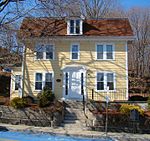Converse House and Barn
Barns on the National Register of Historic Places in ConnecticutGothic Revival architecture in ConnecticutHistoric American Buildings Survey in ConnecticutHistoric district contributing properties in ConnecticutHouses completed in 1870 ... and 4 more
Houses in Norwich, ConnecticutHouses on the National Register of Historic Places in ConnecticutNRHP infobox with nocatNational Register of Historic Places in New London County, Connecticut

The Converse House and Barn are a historic residential property at 185 Washington Street in Norwich, Connecticut. Built about 1870 for a local businessman and philanthropist, it is a prominent local example of High Victorian Gothic architecture. The property was listed on the National Register of Historic Places in 1970, and is included in the Chelsea Parade Historic District.
Excerpt from the Wikipedia article Converse House and Barn (License: CC BY-SA 3.0, Authors, Images).Converse House and Barn
Washington Street, Norwich Norwichtown
Geographical coordinates (GPS) Address Nearby Places Show on map
Geographical coordinates (GPS)
| Latitude | Longitude |
|---|---|
| N 41.534166666667 ° | E -72.083333333333 ° |
Address
Washington Street 188
06360 Norwich, Norwichtown
Connecticut, United States
Open on Google Maps










